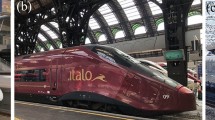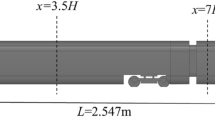Abstract
The impact of bogie sections on the wake dynamics of a high-speed train (HST) is numerically explored using the improved delayed detached eddy simulation (IDDES). Time-averaged and instantaneous wake flow topology are compared for two underbody configurations: the complex train model (CTM) with bogie sections and the simplified train (STM) with a flat underbody. For both underbody configurations, a pair of counter-rotating half-loop vortices dominates the unsteady wake. Each member of the vortex pair is shed alternately in the wake of the CTM, which is attributed to vortex shedding from the bogie sections. While for the STM, the members of this vortex pair couple and appear simultaneously. The dynamic characteristics of the wake are clarified by using proper orthogonal decomposition (POD) analysis for the IDDES results. The first four POD modes, corresponding to the dominant vortex structures, are analysed in detail, which confirms the significant impact of bogie sections on the wake dynamics of a HST.





















Similar content being viewed by others
Abbreviations
- St w :
-
Strouhal number
- f :
-
The frequency
- D :
-
The hydraulic diameter
- U * :
-
The streamwise velocity
- W :
-
The train width
- U ∞ :
-
The oncoming flow velocity
- u * :
-
The friction velocity
- n :
-
The distance between the first node and the train surface in the wall normal direction
- Δl :
-
The cell width in the streamwise direction
- Δs :
-
The cell width in the spanwise direction
- h wn :
-
The grid step in the wall-normal direction
- C w :
-
An empirical constant
- h max :
-
The largest local grid spacing
- h x :
-
Local streamwise cell size
- h y :
-
Local wall-normal cell size
- h z :
-
Local lateral cell size
- t * :
-
t* = H/U∞
- C D :
-
The force coefficient
- F x :
-
The drag force
- ρ :
-
The density of the air
- A x :
-
The projected area in the x direction
- C P :
-
The pressure coefficient
- P :
-
The time-averaged surface pressure
- P ∞ :
-
The static pressure
- u :
-
The velocity in the X direction
- v :
-
The velocity in the Y direction
- w :
-
The velocity in the Z direction
- U mean :
-
Time-averaged x-direction velocity
- V mean :
-
Time-averaged y-direction velocity
- U RMS :
-
x-direction velocity fluctuation
- V RMS :
-
y-direction velocity fluctuation VRMS
- ω x * :
-
x-direction vorticity
- ω z * :
-
z-direction vorticity
- a j :
-
The temporal coefficients of the POD modes
References
Baker, C.J.: The flow around high speed trains. J. Wind Eng. Ind. Aerodyn. 98(6), 277–298 (2010). https://doi.org/10.1016/j.jweia.2009.11.002
Bell, J.R., Burton, D., Thompson, M., Herbst, A., Sheridan, J.: Wind tunnel analysis of the slipstream and wake of a high-speed train. J. Wind Eng. Ind. Aerodyn. 134, 122–138 (2014). https://doi.org/10.1016/j.jweia.2014.09.004
Bell, J.R., Burton, D., Thompson, M.C., Herbst, A.H., Sheridan, J.: Dynamics of trailing vortices in the wake of a generic high-speed train. J. Fluid. Struct. 65, 238–256 (2016). https://doi.org/10.1016/j.jfluidstructs.2016.06.003
Bell, J.R., Burton, D., Thompson, M.C., Herbst, A.H., Sheridan, J.: Flow topology and unsteady features of the wake of a generic high-speed train. J. Fluid. Struct. 61, 168–183 (2016). https://doi.org/10.1016/j.jfluidstructs.201511.009
Xia, C., Wang, H.F., Shan, X.Z., Yang, Z.G., Li, Q.L.: Effects of ground configurations on the slipstream and near wake of a high-speed train. J. Wind Eng. Ind. Aerodyn. 168, 177–189 (2017). https://doi.org/10.1016/j.jweia.2017.06.005
Pope, C.W., 2007, "Effective Management of Risk from slipstream effects at trackside and platforms," Rail Safety and Standards Board – T425 Report
Baker, C.J., Quinn, A., Sima, M., Hoefener, L., Licciardello, R.: "Full-scale measurement and analysis of train slipstreams and wakes," part 1: ensemble averages. Proc. Inst. Mech. Eng. Part F: J. Rail Rapid Transp. 228(5), 451–467 (2014). https://doi.org/10.1177/0954409713485944
Baker, C.J., Quinn, A., Sima, M., Hoefener, L., Licciardello, R.: "Full-scale measurement and analysis of train slipstreams and wakes," part 2: gust analysis. Proc. Inst. Mech. Eng. Part F: J. Rail Rapid Transp. 228(5), 468–480 (2014). https://doi.org/10.1177/0954409713488098
Baker, C.J., Dalley, S.J., Johnson, T., Quinn, A., Wright, N.G.: The slipstream and wake of a high-speed train. Proc. Inst. Mech. Eng. Part F: J. Rail Rapid Transp. 215(2), 83–99 (2001). https://doi.org/10.1243/0954409011531422
Gilbert, T., Baker, C.J., Quinn, A.: Gusts caused by high-speed trains in confined spaces and tunnels. J. Wind Eng. Ind. Aerodyn. 121, 39–48 (2013). https://doi.org/10.1016/j.jweia.2013.07.015
Weise, M., Schober, M., Orellano, A.: Slipstream velocities induced by trains. WSEAS Transactions on Fluid Mechanics. 1(6), 759–761 (2006)
Schulte-Werning, B., Heine, B., Matschke, C.: Unsteady wake flow characteristics of high-speed trains. Proc. Appl. Maths Mech. 2(1), 332–333 (2003)
Muld, T.W., Efraimsson, G., Henningson, D.S.: Flow structures around a HST extracted using proper orthogonal decomposition and dynamic mode decomposition. Comput. Fluids. 57, 87–97 (2012). https://doi.org/10.1016/j.compfluid.2011.12.012
Pii, L., Vanoli, E., Polidoro, F., Gautier, S., and Tabbal, A., 2014, "A Full Scale Simulation of a High Speed Train for Slipstream Prediction," in: Proceedings of the Transport Research Arena, Paris, France
Östh, J., Kaiser, E., Krajnović, S., Noack, N.R.: Cluster-based reduced-order modelling of the flow in the wake of a high speed train. J. Wind Eng. Ind. Aerodyn. 145, 327–338 (2015). https://doi.org/10.1016/j.jweia.2015.06.003
Wang, S.B., Burton, d., Herbst, A., Sheridan, J., Thompson, M.C.: The effect of bogies on high-speed train slipstream and wake. J. Fluids Struct. 83, 471–489 (2018). https://doi.org/10.1016/j.jfluidstructs.2018.03.013
Xia, C., Shan, X.Z., Yang, Z.G.: Detached-Eddy simulation of ground effect on the wake of a high-speed train. J. Fluids Eng. 139(5), 1–12 (2017). https://doi.org/10.1115/1.4035804
Xia, C., Wang, H.F., Bao, D., Yang, Z.G.: Unsteady flow structures in the wake of a high-speed train. Exp. Thermal Fluid Sci. 98, 381–396 (2018). https://doi.org/10.1016/j.expthermflusci.2018.06.010
Bourgeois, J.A., Sattari, P., Martinuzzi, R.J.: Alternating half-loop shedding in the turbulent wake of a finite surface-mounted square cylinder with a thin boundary layer. Phys. Fluids. 23(9), 095101 (2011). https://doi.org/10.1063/1.3623463
Wang, S.B., Bell, J.R., David, B., Herbst, A.H., Sheridan, J., Thompson, M.C.: The performance of different turbulence models (URANS, SAS and DES) for predicting HST slipstream. J. Wind Eng. Ind. Aerodyn. 165, 46–65 (2017). https://doi.org/10.1016/j.jweia.2017.03.001
Tschepe, J., Fischer, D., Nayeri, C.N., Paschereit, C.O., Krajnovic, S.: Investigation of high-speed train drag with towing tank experiments and CFD. Flow, Turbulence and Combustion. 102, 1–18 (2018). https://doi.org/10.1007/s10494-018-9962-y
Morden, J.A., Hemida, H., Baker, C.J.: Comparison of RANS and detached eddy simulation results to wind-tunnel data for the surface pressures upon a class 43 high-speed train. J. Fluids Eng. 137(4), 1–9 (2015). https://doi.org/10.1115/1.4029261
Rao, A.N., Zhang, J., Minelli, G., Basara, B., Krajnović, S.: An LES investigation of the near-wake flow topology of a simplified heavy vehicle. Flow, Turbulence and Combustion. 102, 1–27 (2018). https://doi.org/10.1007/s10494-018-9959-6
Shur, M.L., Spalart, P.R., Strelets, M.K., Travin, A.K.: A hybrid RANS-LES approach with delayed-DES and wall-modelled LES capabilities. Int. J. Heat Fluid Flow. 29(6), 1638–1649 (2008). https://doi.org/10.1016/j.ijheatfluidflow.2008.07.001
Spalart, P.R.: Detached-eddy simulation. Ann. Rev. Fluid Mech. 41(1), 181–202 (2009). https://doi.org/10.1146/annurev.fluid.010908.165130
Huang, S., Hemida, H., Yang, M.Z.: Numerical calculation of the slipstream generated by a CRH2 high-speed train. Proc. Inst. Mech. Eng. Part F: J. Rail Rapid Transp. 230(1), 103–116 (2016)
Travin, A., Shur M.L, Strelets M.K, and Spalart, P.R., 2000, "Physical and numerical upgrades in the detached-eddy simulation of complex turbulent flows," In Proceedings of the 412th Euromech Colloquium on LES and Complex Transitional and Turbulent Flows, Munich, Germany
Flynn, D., Hemida, H., Soper, D., Baker, C.J.: Detached-eddy simulation of the slipstream of an operational freight train. J. Wind Eng. Ind. Aerodyn. 132, 1–12 (2014). https://doi.org/10.1016/j.jweia.2014.06.016
Flynn, D., Hemida, H., Baker, C.J.: On the effect of crosswinds on the slipstream of a freight train and associated effects. J. Wind Eng. Ind. Aerodyn. 156, 14–28 (2016). https://doi.org/10.1016/j.jweia.2016.07.001
Sirovich, L.: Turbulence and the dynamics of coherent structures part I: coherent structures. Q. Appl. Math. 45(3), 561–571 (1987)
Taira, K., Brunton, S.L., Dawson, S.T., Rowley, C.W., Colonius, T., McKeon, B.J., Schmidt, O.T., Gordeyev, S., Theofilis, V., Ukeiley, L.S.: Modal analysis of fluid flows: an overview. AIAA J. 55(12), 4013–4041 (2017). https://doi.org/10.2514/1.J056060
Wang, H.F., Cao, H.L., Zhou, Y.: POD analysis of a finite-length cylinder near wake. Exp. Fluids. 55(8), (2014). https://doi.org/10.1007/s00348-014-1790-9
Zhu, H.Y., Wang, C.Y., Wang, H.P., Wang, J.J.: Tomographic PIV investigation on 3D wake structures for flow over a wall-mounted short cylinder. J. Fluid Mech. 831, 743–778 (2017). https://doi.org/10.1017/jfm.2017.647
Wei, Z., Yang, Z.G., Xia, C., Li, Q.L.: Cluster-based reduced-order modelling of the wake stabilization mechanism behind a twisted cylinder. J. Wind Eng. Ind. Aerodyn. 171, 288–303 (2017). https://doi.org/10.1016/j.jweia.2017.10.015
Hemida, H., Baker, C.J., Gao, G.: The calculation of train slipstreams using large-eddy simulation. Proc. Inst. Mech. Eng. Part F: J. Rail Rapid Transp. 228(1), 25–36 (2013). https://doi.org/10.1177/0954409712460982
Yao, S.B., Sun, Z.X., Guo, D.L., Chen, D.W., Yang, G.W.: Numerical study on wake characteristics of high-speed trains. Acta Mech. Sinica. 29(6), 811–822 (2013). https://doi.org/10.1007/s10409-013-0077-3
Jeong, J., Hussain, F.: On the identification of a vortex. J. Fluid Mech. 285, 69–94 (1995). https://doi.org/10.1017/S0022112095000462
Hosseini, Z., Bourgeois, J.A., Martinuzzi, R.J.: Large-scale structures in dipole and quadrupole wakes of a wall-mounted finite rectangular cylinder. Exp. Fluids. 54(9), 1–16 (2013). https://doi.org/10.1007/s00348-013-1595-2
Saeedi, M., Lepoudre, P.P., Wang, B.C.: Direct numerical simulation of turbulent wake behind a surface-mounted square cylinder. J. Fluid Struct. 51, 20–39 (2014). https://doi.org/10.1016/j.jfluidstructs.2014.06.021
Saeedi, M., Wang, B.C.: Large-eddy simulation of turbulent flow around a finite-height wall-mounted square cylinder within a thin boundary layer. Flow Turbul. Combust. 97(2), 513–538 (2016). https://doi.org/10.1007/s10494-015-9700-7
Pan, Y.C., Yao, J.W., Li, C.F.: Discussion on the wake vortex structure of a high speed train by vortex identification methods. Chinese Journal of Theoretical and Applied Mechanics. 50(3), 667–676 (2018)
Niu, J.Q., Wang, Y.M., Zhang, L., Yuan, Y.P.: Numerical analysis of aerodynamic characteristics of high-speed train with different train nose lengths. Int. J. Heat Mass Transf. 127, 188–199 (2018). https://doi.org/10.1016/j.ijheatmasstransfer.2018.08.041
Acknowledgements
This work was supported by the National Natural Science Foundation of China (Grand No. 51875411), Shanghai Key Laboratory of Aerodynamics and Thermal Environment Simulation for Ground Vehicles (Grand No. 18DZ2273300) and Shanghai Automotive Wind Tunnel Technical Service Platform (Grand No. 19DZ2290400). The computing facility and aero-acoustic wind tunnel of Shanghai Key Lab of Vehicle Aerodynamics and Vehicle Thermal Management Systems is gratefully acknowledged.
Author information
Authors and Affiliations
Corresponding author
Ethics declarations
Conflict of Interests
The authors declare that they have no conflict of interest.
Rights and permissions
About this article
Cite this article
Zhou, Z., Xia, C., Shan, X. et al. The Impact of Bogie Sections on the Wake Dynamics of a High-Speed Train. Flow Turbulence Combust 104, 89–113 (2020). https://doi.org/10.1007/s10494-019-00052-w
Received:
Accepted:
Published:
Issue Date:
DOI: https://doi.org/10.1007/s10494-019-00052-w




